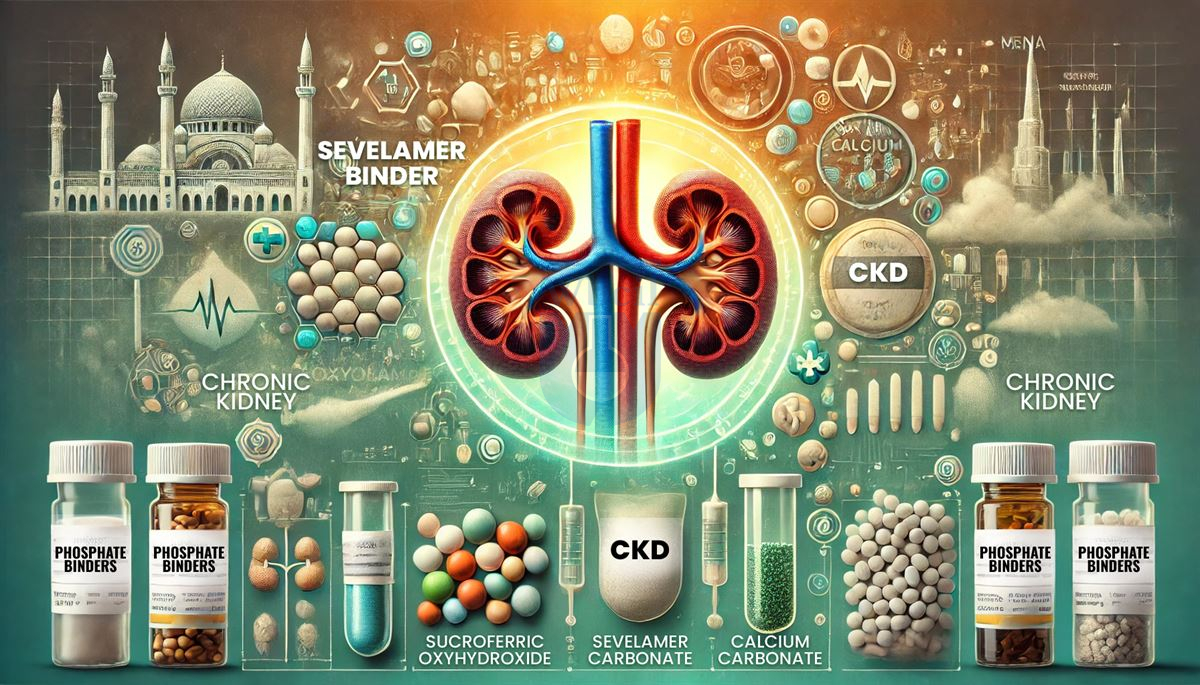Phosphate Binders in Hyperphosphatemia: Sucroferric Oxyhydroxide vs Other
Managing hyperphosphatemia is crucial for patients with chronic kidney disease (CKD), particularly in the MENA region, where chronic kidney disease prevalence is rising. High phosphate levels in the blood can lead to severe complications, including bone disorders and cardiovascular diseases. Phosphate binders; such as sucroferric oxyhydroxide, sevelamer, and calcium carbonate, are essential for managing this condition. This article compares these treatments to help patients in countries like Saudi Arabia, United Arab Emirates (UAE), Egypt, Jordan, and Kuwait make informed decisions.
The Importance of Phosphate Binders in Treating Hyperphosphatemia
Hyperphosphatemia is a common complication of CKD, occurring when damaged kidneys cannot remove excess phosphate from the blood. Untreated, it leads to vascular calcification, weak bones, and cardiovascular disease. Phosphate binders work by attaching to dietary phosphate in the digestive system, preventing its absorption into the bloodstream. This management protects bone and cardiovascular health, making it a cornerstone of CKD treatment in the MENA region, where dietary habits often include phosphate-rich foods.

What is Sucroferric Oxyhydroxide?
Sucroferric Oxyhydroxide is an advanced iron-based phosphate binder with high efficacy and minimal side effects. It binds to phosphate in the gastrointestinal tract, reducing its absorption into the bloodstream. This makes it highly effective in lowering serum phosphate levels and mitigating the risks of hyperphosphatemia.
Key features of Sucroferric Oxyhydroxide include:
- High binding efficacy requiring fewer daily doses, which improves patient compliance.
- Minimal systemic absorption of iron, reducing the risk of iron overload.
- Improved tolerability, with fewer gastrointestinal side effects than other binders.
Its safety and efficacy make it particularly beneficial for CKD patients in countries like Oman, Bahrain, and Lebanon, where long-term management of phosphate levels is essential.
Common Phosphate Binders for CKD in the MENA Region
Aside from Sucroferric Oxyhydroxide, other widely used phosphatase inhibitors include:
- Sevelamer:
- A non-calcium-based binder.
- Effective in lowering serum phosphate levels.
- Offers additional benefits, such as lowering cholesterol.
- Common side effects include bloating and constipation.
- Calcium Carbonate:
- A calcium-based phosphate binder that is affordable and accessible in Egypt, Jordan, and Iraq.
- Effective for managing phosphate levels but carries a higher risk of vascular calcification and hypercalcemia, making it unsuitable for some patients.
Sucroferric Oxyhydroxide vs. Sevelamer
Efficacy
Both Sucroferric Oxyhydroxide and Sevelamer are effective in reducing serum phosphate levels. However, Sucroferric Oxyhydroxide offers a higher phosphate-binding capacity, allowing patients in Saudi Arabia and UAE to take fewer pills daily, enhancing adherence.
Tolerance and Gastrointestinal Effects
Patients in Kuwait and Qatar often report better gastrointestinal tolerability with Sucroferric Oxyhydroxide compared to Sevelamer, which is associated with bloating and constipation.
Cost and Availability
In the MENA region, Sucroferric Oxyhydroxide may be more expensive than Sevelamer, but its superior efficacy and fewer side effects justify the cost for many patients. Availability varies by country, so patients in Lebanon and Oman should consult local pharmacies or healthcare providers.

Advantages of Sucroferric Oxyhydroxide Over Calcium Carbonate
Sucroferric Oxyhydroxide offers significant advantages over Calcium Carbonate, which is commonly used in countries like Egypt and Jordan.
- Reduced Risk of Vascular Calcification: Unlike Calcium Carbonate, Sucroferric Oxyhydroxide does not raise calcium levels, reducing the risk of vascular calcification.
- Improved Safety Profile: It minimizes the risk of hypercalcemia, making it safer for patients in Qatar and UAE who are prone to high calcium levels.
- Higher Efficacy: Sucroferric Oxyhydroxide binds phosphate more effectively without causing calcium overload, making it a preferred option in Saudi Arabia.
Common Side Effects of Phosphate Binders
While phosphate binders are generally safe, they can have side effects:
- Sucroferric Oxyhydroxide: Mild gastrointestinal symptoms like dark stools or diarrhea.
- Sevelamer: Gastrointestinal discomfort, including bloating and constipation.
- Calcium Carbonate: Risk of hypercalcemia, leading to complications such as vascular calcification.
Patients in Bahrain and Kuwait often report fewer side effects with Sucroferric Oxyhydroxide, making it a more tolerable choice for long-term use.
How to Choose the Right Phosphate Binder
Selecting the right phosphatase inhibitor depends on several factors:
- Patient-Specific Needs: Factors such as CKD stage, dietary habits, and medication tolerance are crucial in countries like Oman and Lebanon, where CKD prevalence varies.
- Availability in Local Markets: In Egypt, Jordan, and Saudi Arabia, availability may influence the choice of medication. Patients should consult local healthcare providers to ensure access to their preferred binder.
- Physician Recommendations: Healthcare providers in UAE, Qatar, and Bahrain can help tailor treatment plans based on individual needs, ensuring safe and effective management of hyperphosphatemia.
Conclusion: The Best Option for Treating Hyperphosphatemia
For CKD patients in the MENA region, Sucroferric Oxyhydroxide offers significant advantages, including high efficacy, better tolerability, and a safer profile compared to sevelamer and calcium carbonate. While cost and availability may vary, its ability to effectively manage serum phosphate levels with fewer side effects makes it an excellent choice for many patients.
Patients in Saudi Arabia, UAE, Egypt, Jordan, Kuwait, and other MENA countries should consult their healthcare providers to determine the most suitable phosphate binders for their specific needs. By addressing hyperphosphatemia effectively, CKD complications can be minimized, improving the quality of life for patients across the region.
